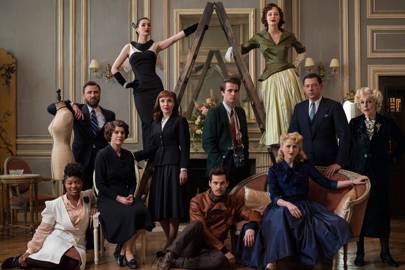Personal scandal, political intrigue, and murder make
for just another day at the office at the House of Sabine in The Collection. The nourish series
follows the fictional fashion house as its staff maneuver the ruthless world of
post-war couture in which high fashion equals even higher stakes. At once a
sleek modern drama and a celebration of post-war noir the series stakes for viewing
that will enthrall film buffs and casual viewers alike. Through its scathing
script and razor sharp performances The
Collection brings the ugly side of post-war fashion to life without ever
being anything less than chic.
 |
| Beauty equals pain, and pain equals beauty |
The series begins at the end of World War II as Paris
slowly emerges from the shadow of occupation. Even as the city begins to
recover, its once dominant fashion houses struggle to keep pace with an
industry that has effectively moved on without them. The House of Sabine
manages to rise above the fray, however, thanks to the innovative designs of
Monsieur Sabine. The only problem is that the Monsieur Sabine designing the
house’s collections is not Paul Sabine, whose name appears on the dress labels,
but his reclusive brother, Claude. In an effort to secure the company’s image
and protect Claude’s privacy the brothers agreed that the more business and
media savvy Paul would be the store’s public face while Claude would work
behind the scenes. When Claude begins to question his role in the company,
however, Paul resorts to increasingly desperate and ruthless means to maintain
his position both at the head of the House of Sabine and at the front of the
reemerging Parisian fashion industry.
Inspired by the early days of Christian Dior and his
1950’s ‘new look’, The Collection is
a fascinating journey into both the gritty streets of post-war Paris and the
glamorous world of high fashion. Through the intertwining stories of the
house’s staff the series expertly captures the ways in which France remained
haunted by war-time trauma long after liberation. This is perhaps best captured
in the contrasting stories of Jewish seamstress turned model Nina, who remains
by the loss of her father during the Holocaust, and Paul, who lives under the
constant threat of exposure for his war-time collaboration. Through these
opposing storylines the series presents a wide spectrum of ways in which
Parisians were impacted by and coped with Nazi occupation. The series also
portrays the impact of World War II upon Parisian business with equal skill as
it shows Paul’s struggles to sell high fashion to a population who are still
struggling with a shattered economy. While the story provides viewers with a
fascinating look at life in post-war Paris, perhaps its greatest strength is
its exploration of the fashion industry at its most ferocious. Through its
portrayal of the crosses, double-crossess, underhanded dealings, and deceptions
that Sabine and his staff are constantly engaged in the series creates an image
of the fashion world that makes the characters in The Devil Wears Prada look congenial. This journey into the
industry’s underbelly lends the script a surprisingly contemporary feel as it
trades in PBS charm for some of the grittiest period drama since Boardwalk Empire. As a result, the
series remains true to its period setting while still maintaining the interest
of today’s viewers.
/cdn.vox-cdn.com/uploads/chorus_image/image/53602403/TC.04262_JTapproved_new.lg.0.jpg) |
| The stuff that postcards are made of |
The series brings the bleak streets of post-war Paris
and the runways of high fashion to vivid life thanks to the work of its
talented cast. Is brilliant in her performance as the tortured Nina (Jenna Thiam). Max Deacon makes for
an endearing everyman as idealistic American photographer Billy. Frances de la Tour is wonderfully
wicked in her turn as Paul and Claude’s ruthless mother, Yvette. Richard Coyle expertly captures
Paul’s outward easy charm and inner ruthlessness with equal skill. Tom Riley steals each
scene in which he appears as ingenious, but self-destructive, Claude.
A period piece with a contemporary twist, The Collection captures the best in
today’s television trends. Through its intelligent script and excellent acting
the series provides cutting edge entertainment that will appeal to classic noir
connoisseurs and fans of contemporary drama alike. For a classic drama with
contemporary style take a sample of The
Collection.
 |
| One big back-stabbing family |

No comments:
Post a Comment